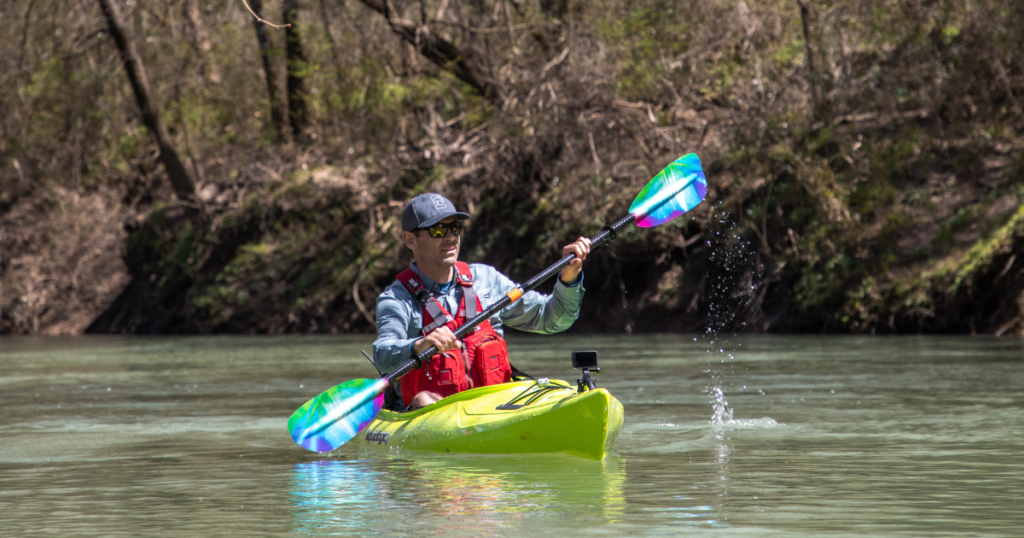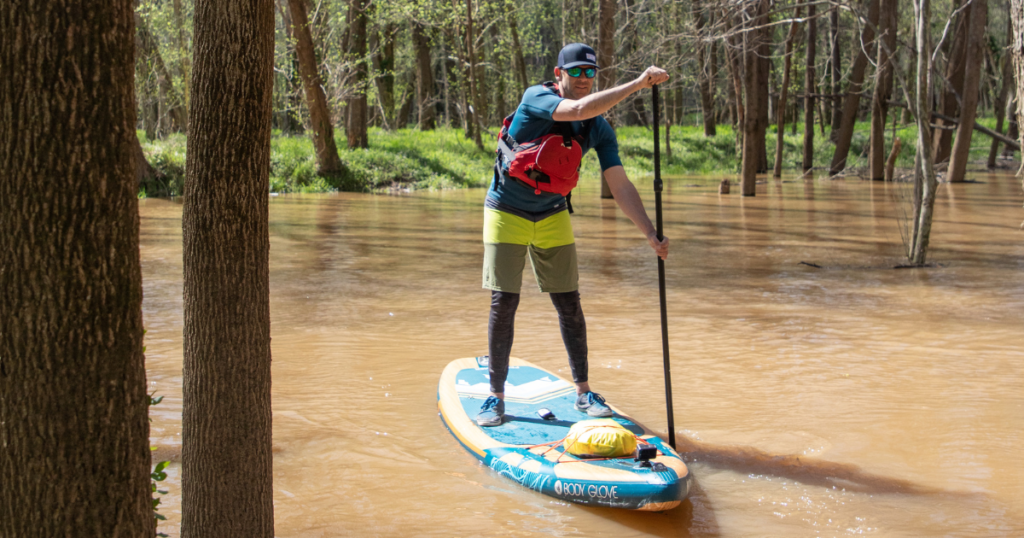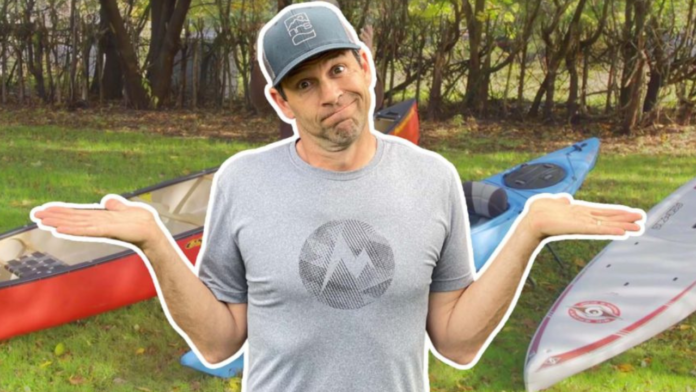The big question for new paddlers is: canoe vs kayak vs stand up paddleboard? Well, you'll certainly find passionate defenders of all three options. The key is to narrow down what kinds of adventures you envision yourself going on. It's also important to compare things like performance and stability with the budget and ability of yourself and anyone else in your family or group.
I'm going to break down many of the common questions and concerns for each of these vessels and, hopefully, shine some light on the choices of canoe vs kayak vs SUP.

Is a canoe the right choice?
Canoes are the kings of camping trips, especially ones that involve portages. Portages are land routes for carrying your craft and your gear from one body of water to another. This is because canoes can store a lot of gear (essential and indulgent) in things like backpacks or large containers. These can then be carried more easily during the portage.
Potentially even at the same time as your canoe if you're strong enough or masochistic in nature. Anyone who has mastered the one-trip grocery carry will excel here. Canoes are also great for family trips. They allow for bringing the kids and the dog, safely and easily in the same boat.
How to select the right canoe?
First time canoeists will want to consider a recreational or a multi-purpose model. The former prioritizes stability over agility and is best for easy-going days on flatwater, including fishing. The latter offers a higher carrying capacity for those multi-day trips. As well as some extra maneuverability to enhance paddling performance in some more adventurous conditions. From there, things like dimensions, design features, and materials should all be considered.
What is more stable, canoe vs kayak?
Kayaks tend to be more stable since they sit lower on the water and have a lower center of gravity. Therefore kayaks don't get pushed around as much in windy and wavy conditions. For either craft, recreational models are designed to be the most stable.
Do canoes flip over easier?
Potentially. Canoes have a higher center of gravity and so they are more easily influenced by destabilizing movements or conditions. If you or your passengers shift about erratically, or if some unexpected turbulence arises, then yes, the canoe might capsize. The more experienced the canoeist gets with paddling and understanding/responding to the environment, the less likely this becomes. And again, a recreational canoe will be designed to help combat flipping.
what is faster canoe vs kayak?
If all factors are equal, generally kayaks are faster since the double-bladed paddle and the design of the craft is better suited to performance. That being said, with two committed and synchronized paddlers, a canoe can definitely whiz.
How much does a canoe cost?
As with all sporting goods equipment, canoes come with a wide range of price tags. The average retail price for a new canoe tends to be around $900-$1000 USD. This can range from $600 – $1500, with some entry-level models dipping a bit lower, and several advanced models greatly exceeding this.

Is a kayak the right choice?
Kayaks tag in nicely for people who want to paddle their own boat, and/or feel more stable on the water, and/or engage in some faster, higher performance paddling. The two-bladed paddle offers more control and more power compared to the single bladed paddle of a canoe, and especially a stand up paddleboard.
Because of their lower-profile, and therefore lower center of gravity, kayaks tend to be more stable and can handle wind and waves better than the other two. Kayaks are also a standout option for fishing. In fact, there are a surprising number of models designed specifically for fishing or with fishing in mind.
How to choose a kayak?
Like canoes, kayaks come in all different shapes, sizes, and categories. A different variable that kayaks present is perhaps the first question to consider, namely: Do I want a hard-shell or an inflatable kayak? The deciding factor here tends to be portability and transportability.
For anyone limited in storage space or a vehicle to get the kayak to the water, inflatable kayaks solve both of those problems. Hard-shell kayaks tend to be more comfortable, perform better, and have more features (such as storage for camping and gear tracks for fishing). From there, one's skill level and the expected paddling conditions should be considered across the spectrum of recreational to touring kayaks.
What kayak is best for beginners?
Recreational kayaks are well-suited to beginners as they emphasize stability over performance. This will allow new paddlers, and even kids, to safely acquaint themselves with the sport and develop their passion. Sit-on-top style kayaks also tend to be appealing to beginners as they look more approachable, are easier to hop in and out of, and are easier to manage in the unlikely event of a capsize.
Are kayaks easy to flip?
It depends. If the kayak is a wide, recreational model, with a flat hull, and the conditions are calm, then you'd have to be pretty determined to flip it. Most beginners will find themselves in this kind of set up. However, if someone of modest experience were to jump in a higher performance kayak, especially in rough conditions, then a capsize could certainly happen.
Is a kayak for one person?
Most kayaks are designed for one person, although tandem kayaks are available. The one-person design is great for paddling autonomy, while the tandem style opens the door to family outings. With a young child up front, paddling becomes a fun option to dip in and out of – or they can simply enjoy the time on the water while mom or dad does the grunt work from the back seat.
Are kayaks heavy?
They can be, but there are many lightweight models out there too. If weight is a concern, then the best options are inflatable or recreational kayaks, which typically weigh around 20 – 40 pounds (9-18 kilograms). Some fishing-specific kayaks can be quite heavy – weighing over 100 pounds (45 kilograms).
How much does a kayak cost?
Beginner paddlers who gravitate toward inflatable or recreational hard-shell kayaks can expect to pay around $300 – $1000 USD. The price ranges increase for performance kayaks and fishing kayaks.

Is a Stand Up Paddleboard the right choice?
SUPs aren't as stable as canoes or kayaks, they're a lot slower, and they aren't as good for covering long distances. So why are they in the discussion for new paddlers? They're fun, easy to get started with, and a great workout. This is why paddleboards are so popular around the cottage and are often rented at lakeside beaches.
How to choose a stand up paddle board
A paddler's weight and experience level should be considered when buying a paddleboard. The wider, longer, and thicker the board is, the more buoyancy and stability it will have. An inflatable model is another appealing variable, just remember that the easier transportation comes with the time/energy cost of inflation, drying, and packing.
Is Stand Up Paddleboarding good exercise?
Yes! Depending on who you ask, this is the beauty of a stand up paddleboard. It is hard work to carry and/or inflate a paddleboard, it's difficult to balance on, and it takes sustained effort to cover any ground while paddling. This is why it makes for such a great workout. SUPs promote stable legs, a strong core, and will give a balanced upper body pump (so long as you remember to work your weak side just as much). For an even more advanced workout, try introducing some yoga – but be prepared to get wet.
Are SUPs inflatable?
They sure can be. If you're a weekend warrior who is short on storage space then an inflatable SUP can be a wonderful asset. However, if you have a permanent set up near the water then an epoxy board might make more sense, since it will be ready to hit the water anytime, and will be more durable if kids are dragging it around the shore.
How Much Does a Stand Up Paddle Board Coast?
Inflatable paddle boards are the lesser expensive of the two styles. You might find a starter board for as low as $300 (USD), but that can reach up to $1700 for high-end models. In terms of hard, or epoxy, boards, they are more in the $700 – $2,000 (USD) price range.
Canoe vs Kayak vs SUP?
So there you have it! Three excellent choices for beginner paddlers, and perhaps some helpful tips for existing paddlers who are looking to switch up their craft. There are some pros and cons to consider, depending on your aspirations and set up, but the most important thing is to just get started.
If you've been thinking about paddling, then it's time to take the plunge! Whether you go with a canoe vs kayak vs stand up paddleboard, you'll be out on the water and loving life.
Made in Partnership With:

Special Thanks to:







